In-Depth Exploration of Food Saver Plastic Containers
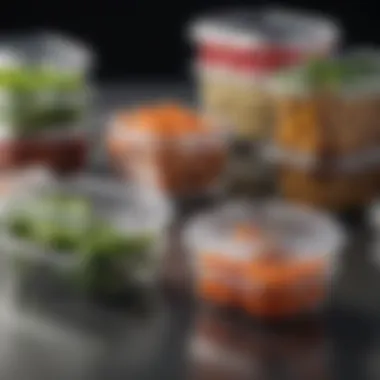
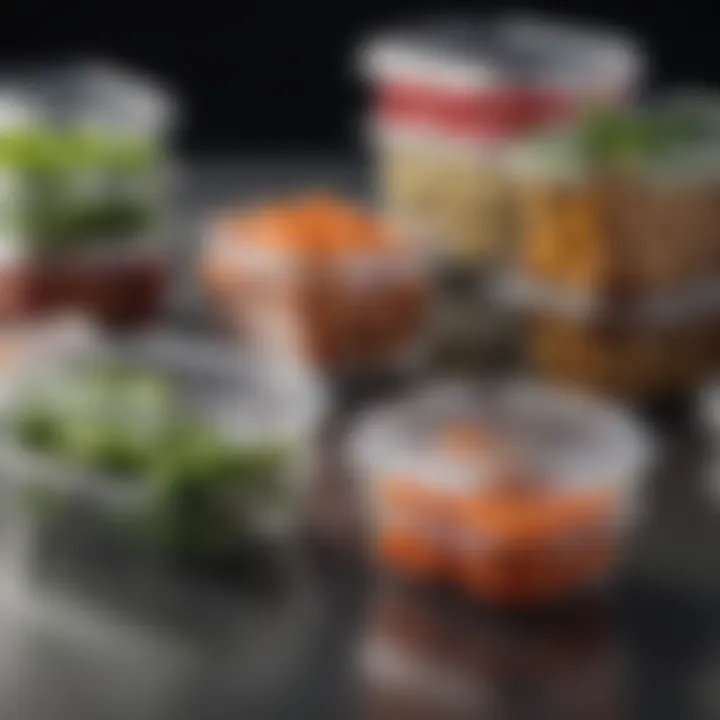
Overview of Topic
Food saver plastic containers serve a vital role in modern kitchens. These containers are specifically designed for the efficient storage of food items, extending freshness and minimizing waste. They come in various shapes and sizes, catering to different needs ranging from meal prep to organizing pantry items. The materials used in their construction, commonly plastics like polyethylene and polypropylene, are chosen for durability and safety.
The importance of these containers cannot be overstated. With increasing awareness around food waste, many individuals and families seek effective solutions to preserve food. Food saver plastic containers not only help in prolonging food freshness but also contribute to minimizing spoilage, thus aiding in better budget management. Furthermore, their design often emphasizes ease of use—features such as stackability and transparent sides facilitate quick identification of contents.
Common Challenges and Solutions
While food saver plastic containers offer numerous benefits, they are not without challenges. Homeowners may encounter several issues when using them, such as:
- Odor retention: Some containers retain smells from previously stored foods, impacting future use.
- Staining: Certain food items can leave permanent stains, particularly if they are stored for extended periods.
- Wear and tear: Over time, containers can become scratched or warped, reducing efficiency.
Solutions and Tips
To address these challenges, consider the following tips:
- For odor retention, wash containers with a mixture of baking soda and water; this can help neutralize any lingering smells.
- To combat staining, opt for containers made from materials specifically labeled as stain-resistant.
- Regularly inspect containers for wear. Replacing them when necessary ensures safety and effectiveness in food storage.
Product Recommendations
When selecting food saver plastic containers, some industry-leading brands stand out:
- Rubbermaid Brilliance: This line features crystal-clear storage that is stain and odor resistant. Its airtight design helps maintain food freshness.
- OXO Good Grips: Known for their practicality, these containers have a unique pop-up button that creates an airtight seal. Easy to stack, they're great for organizing
- Ziploc: Famous for their bags, Ziploc also offers a solid range of containers that are microwave-safe and suitable for various food types.
Benefits and Features
These products distinguish themselves through:
- Durability: Materials used are often BPA-free and designed to withstand temperature changes.
- Versatility: Many containers can be used for both storage and microwave reheating.
- Ease of cleaning: Most are dishwasher safe, making maintenance straightforward.
Step-by-Step Guides
Implementing effective food storage solutions with food saver plastic containers can be broken down into achievable steps:
- Choose the right container: Assess your needs. Are you storing liquids, solids, or leftovers? Select containers that suit these types.
- Prepare the food: Cool down foods before placing them in containers to prevent condensation which can lead to spoilage.
- Store properly: Ensure that you seal containers tightly to maintain freshness. Label them with the contents and date for easy identification.
- Maintain cleanliness: Regularly wash containers after use. Store them in a dry area and periodically check for damage.
By following these guidelines, housewives and house owners can maximize the efficiency of their food saver plastic containers, ultimately enhancing food preservation in their kitchens.
Intro to Food Saver Plastic Containers
Food saver plastic containers are increasingly becoming essential in modern kitchens. They play a pivotal role in preserving the freshness of food, thus reducing waste. Understanding these products is crucial for households aiming to optimize food storage while maintaining its quality. This section will explore the definition, purpose, and history of food preservation techniques, illustrating the significance of food saver plastic containers in our daily lives.
Definition and Purpose
Food saver plastic containers are designed specifically for preserving food and extending its shelf life. They typically feature airtight seals and can be used for both short- and long-term storage. Their purpose is to create an environment that inhibits the growth of bacteria and mold, which can spoil food. This quality is particularly important for those who value sustainability and reduction of food waste. By preventing spoilage, these containers not only save money but also contribute to a more eco-friendly lifestyle. They often come in various sizes and shapes, allowing for efficient organization within the refrigerator or pantry.
History of Food Preservation Techniques
The methods of food preservation have been utilized for thousands of years. Ancient civilizations developed ways to extend the life of food such as drying, smoking, and salting. These techniques were essential for survival during times of scarcity. As time progressed, technologies evolved. The introduction of refrigeration in the 19th century marked a significant advancement, allowing food to be stored longer without spoilage.
In recent decades, food saver plastic containers have emerged as a modern solution for food preservation. They reflect a blend of tradition and innovation, combining ancient preservation techniques with contemporary materials and designs. Today, consumers have access to specialized containers that not only store food but also enhance its longevity, making food saver plastic containers a vital component in efficient food management.
Types of Food Saver Plastic Containers
The category of food saver plastic containers is crucial in understanding the larger context of food preservation. These containers have evolved to meet the varying needs of food storage in the modern kitchen. Within this section, we will explore three dominant types: vacuum sealed containers, airtight food storage containers, and BPA-free options. Each type has its own unique features, benefits, and considerations that distinguish them from one another.
Vacuum Sealed Containers
Vacuum sealed containers are designed to remove air from the storage environment. This process helps in delaying spoilage and maintaining food freshness by minimizing exposure to oxygen. These containers often incorporate special sealing mechanisms that can create an airtight environment. This is beneficial for long-term storage of perishable items such as meats, vegetables, and leftovers.
The vacuum process also helps in preserving the nutrients found in food, ensuring that meals retain their original flavor and texture. They are excellent choices for those who often meal prep or want to stock up on bulk purchases.


How does one use these containers? Typically, you place the food inside, use a vacuum pump or a specific vacuum sealing machine, and seal the lid. It is recommended to follow the manufacturer's guidelines for optimal results. While they are generally easy to use, it's worth noting that improper sealing can lead to air exposure, which compromises the food's longevity.
Airtight Food Storage Containers
Airtight food storage containers serve a slightly different purpose but are equally important. These containers are designed to keep moisture and air out, providing a reliable environment for both dry and refrigerated foods. They often include rubber seals or locking mechanisms that prevent air from entering.
Their versatility allows storage for a broad range of items, including grains, snacks, and cooked meals. An added advantage is that they can help in organizing the kitchen, as many of them come in stackable designs. This can save space and offer a tidier appearance in cabinets or pantries. Some containers are even designed to be microwave and dishwasher safe, enhancing their usability in day-to-day life.
However, it is critical to ensure that the container is indeed airtight. Lower quality options may not provide the same level of sealing effectiveness, leading to potential spoilage of food over time. Checking for user reviews and product details, particularly looking for airtight claims, is advisable when selecting these containers.
BPA-Free Options
While considering the various types of food saver plastic containers, one must also be aware of health-related factors. BPA, or bisphenol A, is a chemical often found in some plastics. Concerns about its effects on health have led to an increased demand for BPA-free options.
These BPA-free containers are made from alternative materials that do not leach toxins into food. They come in multiple types, including vacuum sealed and airtight containers. The significance of choosing these options is particularly relevant for families, where food safety is paramount.
It is easy to find BPA-free options in stores, but it is essential to read labels carefully to verify the claim. Sometimes, manufacturers use terms like "BPA-free" or "does not contain BPA," which suggest that they prioritize consumer health.
"Choosing the right storage container not only preserves food but also enhances the overall kitchen experience."
By taking the time to analyze these options, individuals can tailor their food storage solutions to their specific needs.
Material Considerations for Food Saver Plastic Containers
Understanding the materials utilized in food saver plastic containers is vital for making informed decisions about food storage. Materials not only influence the durability and functionality of containers but also affect food safety and environmental impact. Selecting the right material ensures that food remains fresh while minimizing potential health risks associated with storage.
Polypropylene vs. Polyethylene
When comparing polypropylene and polyethylene, both materials have unique characteristics that make them suitable for food storage. Polypropylene is known for its toughness and resistance to heat. This material can withstand higher temperatures, making it safe for microwave use. It is also less likely to warp during dishwashing, ensuring longevity.
Polyethylene, on the other hand, is more flexible and is often seen in resealable bags. It is effective at providing airtight seals but is less durable than polypropylene. Users should consider the type of food they plan to store. For example, polyproplyene is better for heated food items, whereas polyethylene is appropriate for cold storage or dry goods.
"The choice between polypropylene and polyethylene will depend on the specific needs of food preservation and the conditions of usage."
Both materials are generally safe for food contact, yet it's essential to check if they meet relevant safety standards, such as FDA approvals. Moreover, the recyclability of these materials draws attention, as consumers are increasingly concerned about sustainability.
Glass vs. Plastic Containers
When looking into food storage options, the debate between glass and plastic is significant. Glass containers are favored for several reasons. They do not leach chemicals into food, a common concern with certain plastics. Glass also provides better clarity, allowing users to see the contents easily.
However, glass has its downsides. It is heavier and more susceptible to breaking. This weight might be an inconvenience for daily use. Moreover, some users may prefer lighter options for storage and transport, especially for lunches or picnics.
Contrarily, plastic containers are popular for their lightweight and often lower cost. They are available in a range of shapes and sizes, which adds convenience and versatility. However, the quality of plastics can vary, impacting how well they endure both storage conditions and time. When selecting plastic, look for BPA-free options to ensure they are safe for food storage.
Functionality and Features
The functionality of food saver plastic containers plays a crucial role in effective food preservation. They are designed not only to store food safely but also to enhance the longevity of its freshness and quality. Various features contribute to this primary function, which are tailored to meet the specific needs of modern kitchens. Addressing features such as stackability, microwave safety, and tamper-resistance will allow users to fully utilize their potential in managing food storage.
Stackability for Efficient Storage
Stackability is an essential feature for food saver plastic containers. In a world where kitchen space is often limited, being able to stack containers neatly saves valuable real estate. This design allows for easy organization and access to stored items. Containers designed for stackability often feature uniform shapes and sizes, which makes it easier to group items together.
For instance, a set of stackable containers can be grouped by food type. This way, users can quickly find what they need without digging through multiple containers. Choosing stackable options is particularly beneficial for housewives and house owners seeking to maximize their kitchen space. Moreover, efficient storage helps maintain cleanliness and order, impacting not just aesthetics but practicality in food preparation.
Microwave and Dishwasher Safety
Safety in kitchen appliances is paramount. Food saver plastic containers that are microwave and dishwasher safe offer significant convenience. These containers allow for reheating of leftovers without the need to transfer food to another dish, reducing clean-up time. It is essential, however, to check for specific safety labeling to ensure that the products do not warp or release harmful chemicals when exposed to heat.
The dishwasher safety feature facilitates an easier cleaning process, allowing busy families to maintain hygiene without spending too much time on manual washing. Women and men alike benefit from time saved in the kitchen by selecting containers marked as safe for these appliances.
"Microwave-safe containers help streamline meal prep and clean-up, making them indispensable in family kitchens."
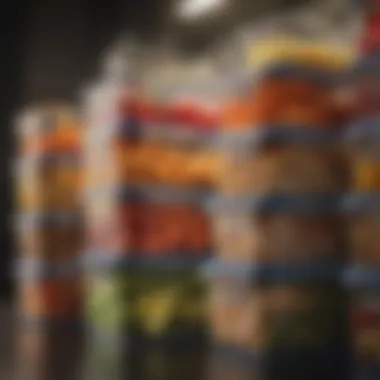
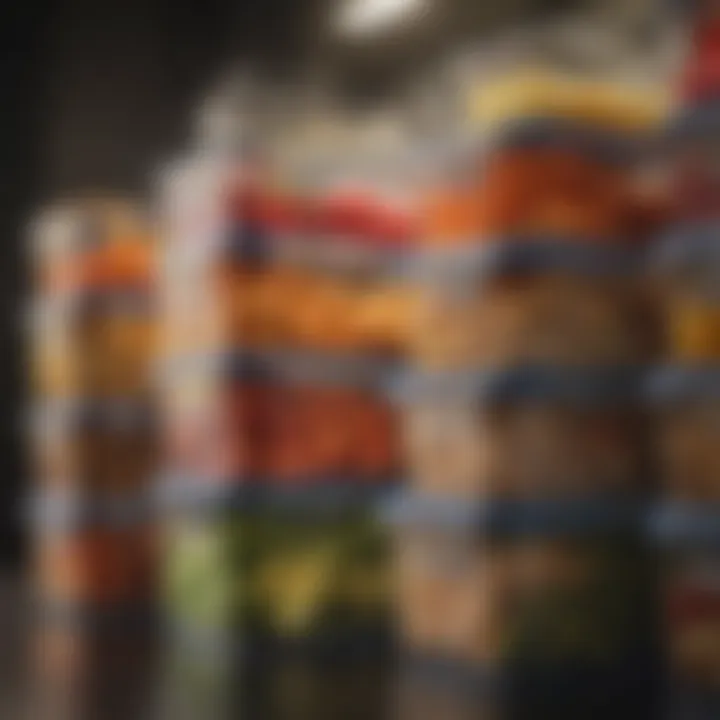
Tamper-Resistant Lids
Tamper-resistant lids on food saver plastic containers provide added security for food storage. These lids create a seal that helps keep food fresh and secure from contaminants. This feature is particularly important for families that value both food safety and quality. The assurance that the food is properly sealed can promote trust and encourage the habit of using stored foods.
Furthermore, tamper-resistant lids prevent accidental opening, particularly in households with children. This ensures that food remains intact until ready for use. The durability of these lids plays a role in maintaining the integrity of the stored food, reducing the likelihood of accidental spills or spoilage.
In summary, understanding the functionality and features of food saver plastic containers can greatly enhance food preservation practices. The purposeful design elements—stackability, microwave safety, and tamper-resistance—contribute to both convenience and safety, resulting in a practical choice for everyday kitchen needs.
Benefits of Using Food Saver Plastic Containers
Food saver plastic containers offer a variety of advantages that can significantly enhance food storage practices. Understanding these benefits allows users to effectively utilize these containers in their kitchens. This section will explore two key benefits: the extended shelf life of food and the reduction of food waste.
Extended Shelf Life of Food
One of the primary advantages of using food saver plastic containers is their ability to extend the shelf life of perishable food items. These containers are designed to create a sealed environment, which helps in minimizing air exposure. When food comes in contact with air, it oxidizes, leading to spoilage and loss of freshness.
By sealing food in airtight containers, deterioration due to oxygen is greatly reduced. For example, fruits and vegetables tend to retain their texture and color longer when stored properly. Similarly, meats and cheeses can maintain their quality, preventing the formation of harmful bacteria. This is a significant consideration for families looking to maintain nutritional value while feeding their households.
Moreover, certain food saver containers come with vacuum-sealing options. This can further enhance preservation capabilities. In turn, this feature is beneficial for bulk buying and meal prepping, allowing families to keep food fresh for extended periods.
Reduction of Food Waste
Another significant benefit is the reduction of food waste. According to various studies, a large portion of food prepared at home does not get consumed and ends up in trash. This not only has an economic impact but also contributes to environmental issues. By using food saver plastic containers, the chances of spoilage decrease substantially.
To maximize food utilization, here are some practical strategies:
- Storage of Leftovers: Properly storing leftover meals in airtight containers allows for easy reheating and reduces the need to cook more food unnecessarily.
- Prepping Ingredients: For individuals who prepare meals in advance, having ingredients stored in food saver containers can help in maintaining their freshness until they are needed.
- Portion Control: Smaller containers can encourage portion control, which helps in reducing over-serving and subsequent waste.
By implementing these strategies, households can transform their food-related practices.
In summary, the benefits of using food saver plastic containers are clear and vital for anyone wanting to enhance their food storage methods. With these containers, families can enjoy a steady supply of fresh food while minimizing waste, ultimately contributing to a more sustainable kitchen environment.
"Using food saver plastic containers is a proactive approach towards sustainability in the kitchen."
Drawbacks and Considerations
When discussing food saver plastic containers, it is essential to analyze the drawbacks and considerations alongside their benefits. While these containers can enhance food preservation and minimize waste, there are critical factors that must be taken into account. Understanding these issues ensures that users can make more informed decisions, leading to better usage and maintenance.
Potential Chemical Leaching
One significant concern associated with plastic containers is potential chemical leaching. Certain food saver plastic containers, especially those made from low-quality materials, may leach harmful chemicals into food. These substances can include bisphenol A (BPA) and phthalates. BPA is particularly notorious as it may imitate hormones in the body, leading to various health issues.
To mitigate this risk, it is better to choose containers specifically labeled as "BPA-free." This labeling indicates that the manufacturer has taken steps to ensure that these harmful chemicals are absent from their products. Furthermore, it is crucial to avoid exposing plastic containers to high temperatures, such as those found in microwaves or dishwashers, as heat can increase the likelihood of leaching. Regular checks for wear and tear can also aid in preventing any health risks associated with damage to the container.
"Prioritizing safety in food storage directly impacts the health of you and your family."
Durability Issues with Low-Quality Products
Another concern is the durability of low-quality plastic containers. Many consumers may fall prey to cheaper options that promise convenience but often fail to deliver in terms of longevity. These containers are prone to cracking, warping, or becoming discolored after repeated use. Such issues can compromise their functionality and lead to food spoilage.
Investing in higher-quality food saver plastic containers is advisable for those who plan to use them frequently. Look for brands known for their durability and reliability. Generally, marked differences can be seen between professionally manufactured products and lower-tier alternatives. Ensure to check reviews and specifications before purchasing to make a wise choice that serves long-term needs.
Best Practices for Usage and Maintenance
Understanding how to effectively use and maintain food saver plastic containers is critical for ensuring their longevity and usability. Adopting best practices can help maximize the container’s potential. Proper care can reduce the risk of damage, maintain food quality, and ultimately enhance the overall food preservation experience. Here, we will discuss proper washing techniques and storage guidelines, which are essential steps in maintaining these containers.
Proper Washing Techniques
Washing food saver plastic containers correctly is an often overlooked but vital aspect of maintaining them. It is important to avoid harsh chemicals or abrasive cleaning tools, as these can harm the container’s integrity. Instead, opt for a mild dish soap and warm water.
- Hand Wash Preferred: Hand washing is often better than dishwasher cycles because it reduces exposure to high heat and harsh detergents.
- Avoid Soaking: Do not soak the containers for extended periods. This can cause warping, especially if the material is not meant for high-heat exposure.
- Use Soft Cloths: Utilize a soft cloth or sponge to clean surfaces, ensuring no scratches or damage occur. Scratches can harbor bacteria and can also diminish the aesthetic quality of the containers.
- Thorough Rinsing: Make sure to rinse thoroughly. Residual soap can compromise food quality.
- Air Drying: Allow containers to air dry completely before storage. This prevents moisture accumulation, which can encourage microbial growth.
Storage Guidelines
Proper storage of food saver plastic containers is equally as important as washing them. Ensuring that they are stored correctly can help prevent damage and maintain their shape.
- Stacking: Many food saver containers are designed for stackability. Utilize this feature to save space and prevent the risk of breakage.
- Avoiding Direct Sunlight: Store containers away from direct sunlight. UV exposure can degrade plastic materials over time.
- Seal Tightly: Always ensure lids are sealed properly before storing food items. This protects against air infiltration and potential spoilage.
- Temperature Considerations: Be mindful of temperature changes, storing in environments that avoid extremes, such as hot attics or damp basements.
- Labeling and Organization: Consider labeling containers for quick identification. This practice can also reduce the risk of mixing expired items with fresh ones.
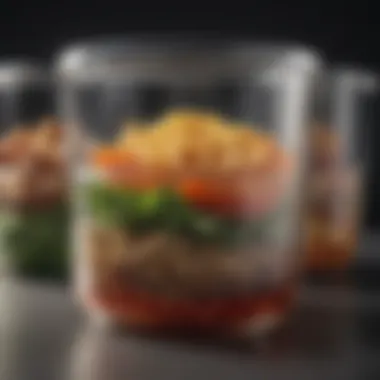
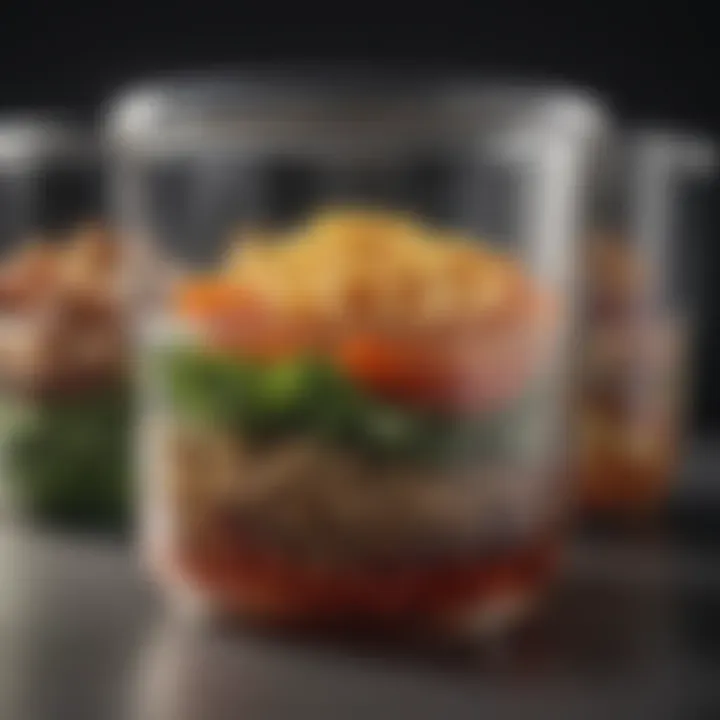
Maintaining food saver plastic containers is essential for food safety and longevity. Proper washing and storage significantly enhance their functionality.
Implementing these best practices will not only lead to better food preservation but also improve your overall experience with food saver plastic containers. By taking the time to care for these essential kitchen tools, you can achieve optimal results in food freshness and flavor.
Environmental Sustainability of Food Saver Plastic Containers
Understanding the environmental sustainability of food saver plastic containers is increasingly critical in today's context of climate change and pollution. This section aims to explore the sustainability aspects of these containers, emphasizing their recyclability, disposal options, and the broader impact of plastic waste on ecosystems. As aware consumers, housewives and homeowners should fully comprehend how their choices in food storage can affect the environment.
Recyclability and Disposal Options
The recyclability of food saver plastic containers depends on the materials used in their construction. Containers made from high-density polyethylene (HDPE) and polypropylene are generally recyclable. Many municipalities have established programs that accept these materials, making disposal more sustainable. When disposing of these containers, it is crucial to check local recycling guidelines. This enhances the likelihood of recycling versus ending up in a landfill.
Benefits of Recycling Food Saver Containers:
- Reduces landfill waste: Recycling minimizes the amount of plastic that reaches landfills, which is ultimately beneficial for the environment.
- Conserves raw materials: By recycling plastic, we can save on the resources needed to produce new plastic products.
- Decreases pollution: Less plastic in landfills leads to lower levels of harmful emissions.
When it comes to disposal, users must remember to clean the containers thoroughly before recycling. Contaminants like food residues can lead to rejection in recycling streams. For those containers that are not recyclable, consider reusing them creatively around the house—this could range from organizing tools to creating storage for small items.
Impact of Plastic Waste on Ecosystems
Plastic waste has severe implications for ecosystems. Every year, millions of tons of plastic enter the oceans, disrupting marine life. Food saver plastic containers, though beneficial in food preservation, can contribute to this pollution if not managed properly. Animals can mistake plastic debris for food, leading to ingestion that often proves fatal.
"Plastic pollution can lead to a substantial decline in biodiversity. Every action taken to reduce plastic waste helps protect ecosystems."
Moreover, plastics in ecosystems break down into microplastics. These microplastics can enter the food chain, affecting not only aquatic life but also human health eventually. Therefore, the impact extends beyond immediate visual pollution and poses long-term risks to both animals and people.
Educating oneself about sustainability in food preservation involves recognizing the consequences of plastic waste. Homeowners can adopt behavior that minimizes their environmental footprint by choosing reusable options, recycling properly, and being mindful of plastic usage.
In summary, while food saver plastic containers can be a practical solution for food preservation, they come with challenges regarding environmental sustainability. Addressing issues of recyclability and understanding the broader impact on ecosystems will enable more responsible choices.
Market Trends and Innovations
The landscape of food saver plastic containers is evolving rapidly as consumer preferences shift towards sustainability and efficiency. It's critical to understand these market trends and innovations because they directly influence product availability and performance. As the demand for eco-friendly and effective food preservation solutions increases, manufacturers respond with new products that meet these expectations. The incorporation of innovative technologies also enhances functionality, making food storage not only more efficient but also more adaptable to contemporary lifestyles.
Emergence of Eco-Friendly Alternatives
In recent years, there has been a significant movement toward eco-friendly alternatives in food storage. Many consumers are now conscious of the environmental impact of plastic use. This awareness has led to more brands focusing on developing biodegradable and compostable materials. These eco-friendly options are emerging as a desirable choice for discerning consumers who prioritize sustainability!
Some key aspects to consider:
- Material Innovation: Manufacturers are experimenting with natural materials derived from plants, such as cornstarch and sugarcane. These materials break down more easily after disposal.
- Recyclability: There is a growing focus on making containers that can be recycled easily. This includes creating containers from widely accepted recycling materials, which helps reduce landfill waste.
- Consumer Education: Companies are increasingly educating their customers about the benefits of choosing eco-friendly options, thus motivating them to switch to sustainable practices in everyday life.
Adopting these alternatives not only benefits the environment but also often leads to better health outcomes by reducing exposure to harmful chemicals commonly found in traditional plastics.
Technological Advances in Food Preservation
Technological innovations play a crucial role in the enhancement of food saver plastic containers. Advances in material science and design have led to the development of containers that offer superior performance in terms of food storage.
Consider these technological innovations:
- Advanced Sealing Technologies: Many modern containers employ advanced sealing systems that maximize freshness by preventing air and moisture from entering. These systems can include vacuum sealing and integrated oxygen absorbers, which significantly prolong the shelf life of food.
- Smart Containers: The rise of smart technology has led to the creation of food storage solutions integrated with apps that can monitor food freshness and remind users when it's time to consume or discard items.
- Multi-Functional Features: Containers now often serve multiple purposes, such as being suitable for freezing, microwave usage, and dishwasher safe. This versatility enhances their value and convenience in busy households.
"The shift towards ecological responsibility in food storage reflects a broader societal trend toward sustainability. Each small change can have a lasting impact on our planet."
By integrating these insights, housewives and homeowners can navigate the market more effectively, ensuring they choose the best options for their needs.
Epilogue
The conclusion serves as a vital component of the article, summarizing key insights into food saver plastic containers. These containers play a significant role in modern food preservation, enabling users to maintain the freshness and longevity of various food items. By understanding their functionality and the materials they are made from, housewives and homeowners can make informed decisions that align with their needs and values.
Final Thoughts on Food Saver Plastic Containers
Food saver plastic containers present an effective solution for anyone looking to minimize food waste while maximizing freshness. Households that embrace these containers often enjoy the benefits of extended shelf life of perishables. The convenience of vacuum sealing and airtight storage allows for a more organized kitchen and helps in meal preparation. These containers simplify the process of preserving leftovers or bulk purchases. However, it is essential to choose high-quality options to avoid issues like leaching, which can occur if subpar materials are used. Investing in well-designed food saver plastic containers can provide significant returns in terms of quality and safety in food storage.
The Future of Food Preservation Solutions
Looking ahead, the landscape of food preservation is evolving rapidly. The increasing consumer awareness regarding sustainability is one of the driving forces shaping this change. Innovations in materials, like plant-based and biodegradable plastics, are emerging as eco-friendly alternatives to traditional plastics. This shift not only addresses the environmental concerns associated with plastic waste but also aligns with the preferences of environmentally conscious consumers. Moreover, technological advancements in vacuum sealing and smart storage solutions are expected to enhance the convenience and efficiency of food preservation further. As the industry progresses, it is crucial to stay informed about these trends to make choices that benefit both the kitchen and the planet.







